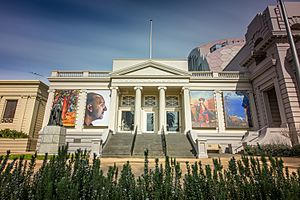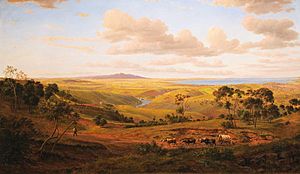Geelong Gallery facts for kids

Geelong Gallery from Johnstone Park
|
|
| Former name | Geelong Art Gallery |
|---|---|
| Established | 1895 |
| Location | 55 Little Malop St, Geelong, Australia |
| Type | Art gallery |
The Geelong Gallery is a fantastic art gallery located in the city of Geelong, Australia. It used to be called the Geelong Art Gallery. This gallery is part of Geelong's special "Cultural Precinct." This area also includes the Geelong Library, the Geelong Arts Centre, and the Geelong Courthouse. It's a place where art, history, and creativity come together!
How the Gallery Started
People in Geelong first asked for an art gallery way back in 1895. In May 1900, the Geelong Art Gallery Association was allowed to use three walls in the Geelong Town Hall to display art. One of the very first artworks they bought was A bush burial by Frederick McCubbin, painted in 1890. It cost 100 guineas, which was about $210 USD back then.
The Geelong Art Gallery officially opened on May 31, 1900, at the town hall. Mr. S. Austin led the event, and Mayor Alderman Carr gave a speech. He officially declared the gallery open for everyone to visit.
The gallery soon moved to the Free Library Building on Moorabool Street. For over 125 years, the Geelong Gallery has collected many important artworks. These include paintings, sculptures, and decorative arts from Australia and Europe. Famous artists like Eugène von Guérard, Clarice Beckett, Emily Kame Kngwarreye, and Frederick McCubbin have their works here.
In 2021, the Geelong Gallery showed a big exhibition about the artist Rone. It displayed his early street art and stencil works. It also featured photos of his amazing art installations in old, empty buildings.
The Gallery Building
The current Geelong Gallery building officially opened in 1915. It was built to honor George M. Hitchcock. The gallery is located next to Johnstone Park. It's between the Geelong Town Hall and the Geelong Library and Heritage Centre.
The first part of the building had a grand entrance facing the park. It also included the G. M. Hitchcock Gallery. More sections were added over the years. The Henry P. Douglas Gallery opened in 1928. Then, the H.F. Richardson Gallery opened in 1937.
The main entrance to the gallery moved to Little Malop Street in 1938. This happened when the J.H. McPhillimy Gallery was opened by the Prime Minister at the time, Joseph Lyons. The gallery expanded again in 1956 and 1971. It also had modern updates in 2001 and 2017.
Gallery Leadership
Humphrey Clegg will become the Director of Geelong Gallery in April 2025.
Jason Smith was the director before him. He then became the director of the Art Gallery of South Australia in Adelaide.
Art Collection

The Geelong Gallery has a collection of over 6,000 artworks. These include Australian and international pieces. You can find drawings, paintings, decorative arts, and sculptures. You can even see many of these artworks on the gallery's website.
Since 2016, the gallery has also looked after the Colin Holden Print Collection. This collection belongs to the Colin Holden Charitable Trust.
Some of the famous artworks in the collection include:
- Eugène von Guérard Aborigines met on the road to the diggings (1854)
- Eugene von Guerard View of Geelong (1856)
- Louis Buvelot On the Woods Point Road (1872)
- Frederick McCubbin A bush burial (1890)
- Edward Fischer Geelong gold cup (1890)
- Stanhope Forbes The pier head (1910) – This painting is considered one of the best British Impressionist paintings in Australia.
- Russell Drysdale Hill End (1948)
- Fred Williams Yellow landscape (1968)
- Rosalie Gascoigne Sharpe Bros horizontal (1981)


